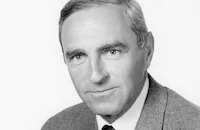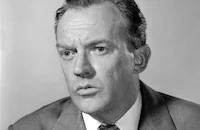Fantastic Voyage

Brief Synopsis
Cast & Crew
Richard Fleischer
Stephen Boyd
Raquel Welch
Edmond O'brien
Donald Pleasence
Arthur O'connell
Film Details
Technical Specs

Synopsis
In 1995 Czech scientist Jan Benes escapes from behind the Iron Curtain and is brought to the United States for interrogation. U. S. scientists are able to reduce objects, including people, to the size of bacteria, but the miniaturization can be sustained for only 60 minutes. The Czech scientist has learned the secret of prolonging the miniaturization; but before he reveals this knowledge, he sustains a severe brain injury which can be treated only from within his body. A plan is conceived whereby a crew of five will be placed in an atomic-powered submarine, miniaturized, injected into the scientist's bloodstream, and set on a course through the arteries to the brain. In addition to American secret agent Grant, the crew consists of Dr. Duval, the surgeon who will perform the operation; Cora Peterson, his assistant; Dr. Michaels, a circulatory expert; and Captain Owens, the sub's pilot. To save some of the 60 minutes, the group decides to stop the scientist's heart to allow the submarine to pass through the heart. Then Grant and the crew leave the sub, and by means of a snorkel tube attached to the patient's lungs, replenish their oxygen supply. As they near their destination, a nurse in the operating room drops a pair of surgical scissors, and the sound causes tremendous vibrations in the sub that hurl the crew from their positions. With only 6 minutes left, Dr. Michaels reveals himself to be an enemy agent intent on sabotaging the mission. The remaining crew members escape as white corpuscles envelop and digest both the submarine and Michaels. The operation is successfully performed by removing a blood clot with a laser beam, and the four survivors leave the scientist's body by swimming along the optic nerve and emerging through a tear duct.

Director

Richard Fleischer
Cast

Stephen Boyd

Raquel Welch

Edmond O'brien

Donald Pleasence

Arthur O'connell
William Redfield

Arthur Kennedy
Jean Del Val

Barry Coe
Ken Scott
Shelby Grant

James Brolin
Brendan Fitzgerald
Crew
L. B. Abbott
Jay Lewis Bixby
Art Cruickshank
Saul David
David Dockendorf
Margaret Donovan
David Duncan
Truman Eli
Peter Foy
Bernard Freericks
Harper Goff
Dale Hennesy
Ollie Hughes
Harry Kleiner
Otto Klement
Emil Kosa Jr.
Richard Kuhn
Ernest Laszlo
Doris Mchale
Michael Mclean
William B. Murphy
National Screen Service
Ben Nye
Stuart A. Reiss
Leonard Rosenman
Ad Schaumer
Marvin Schnall
Walter M. Scott
Jack Martin Smith
Eric Stacey
Bruce Walkup
Fred Zendar

Photo Collections
Videos
Movie Clip





Hosted Intro
Film Details
Technical Specs

Award Wins
Best Art Direction
Best Special Effects
Award Nominations
Best Cinematography
Best Editing
Best Sound Editing
Best Sound Effects Sound Editing
Articles
Fantastic Voyage
The movie began a couple of years before its release with a story treatment that got expanded by famed science fiction author, Isaac Asimov. In writing the screenplay, Asimov felt there were too many compromises and plot holes with the story and asked if he could write a novel based on the story. While novelizations are now commonplace, at the time it was confusing to many viewers, especially since the novel came out first. The reason was because of multiple delays on the set and the speed with which Asimov put the novel together. Both have the same story, but Asimov's book version explains a few things in detail that his screenplay does not.
The story of Fantastic Voyage is fantastic indeed. Both the US and the USSR have developed science for miniaturizing people and objects, but in the case of the United States, only temporarily. After a short while, the people revert back to their normal size. However, a Soviet scientist, who holds the secret to permanently miniaturizing people, has escaped the USSR and been recovered by the CIA. An assassination attempt leaves him with a blood clot on the brain. Rather than risk surgery, they miniaturize a team of specialists who take a miniature sub into his body, make their way to the brain and dispatch of the clot, all before reverting to normal size and thus killing the scientist.
As sci-fi plots go, Fantastic Voyage is a very clever retelling of the exploration theme as well as the ticking time-bomb trope. It's a crew of explorers bounding into undiscovered landscapes, but on a mission that has a countdown attached. Taking that idea and turning it inwards to the human body was definitely a new approach to the theme. Although there was an I Dream of Jeannie episode (no, really) released before the movie that had Captain Nelson (Larry Hagman) on the set of a movie about a miniaturized astronaut going into the body of a Soviet spy, the treatment for Fantastic Voyage was already underway. Besides, after the success of The Incredible Shrinking Man, it was only a matter of time before adventurous tales of miniaturized protagonists hit the big screen again.
Playing the roles of the miniaturized biological warriors and coordinating military team was an assorted cast of old pros and fresh newcomers. There was Stephen Boyd, Edmund O'Brien, Arthur Kennedy, Arthur O'Connell, Donald Pleasence and new bombshell sensation, Raquel Welch. At the time, casting Welch was considered the creation of a new Hollywood sex symbol, but as her theatrical career before and after showed, including her successful run on Broadway in Woman of the Year, she was a well-trained actress who comes off extremely well against her more seasoned colleagues.
Pleasence is superb as always, and O'Connell and O'Brien do their level best to take the proceedings seriously without becoming too overheated. O'Connell succeeds for his part, O'Brien gets a little overheated. Boyd and Kennedy provide the steady core of the movie and while no one will ever say it's their best work, it's pretty good nonetheless.
Behind the camera was the talented pro, Richard Fleischer, whom in 1954, put Jules Verne's 20,000 Leagues Under the Sea up for Disney and it still stands as one of the best adventure movies ever made. In fact, the Proteus, the miniaturized sub for Fantastic Voyage,was designed by Harper Goff, the very same artist who designed the Nautilus for 20,000 Leagues Under the Sea. To say Fleischer does an excellent job is to state the obvious, but it still must be remarked that this type of story in the wrong hands can come off as exceptionally silly and amazingly, Fantastic Voyage does not.
There were a few other movies that later explored similar themes, most notably Inner Space (1987) and Osmosis Jones (2001), but none succeeded quite like Fantastic Voyage. The movie's logical flaws (things left behind in the body that should have killed the scientist when they expanded back to normal size) don't detract as much as amuse. And no, we never did see miniaturized doctors swimming around the blood streams of their patients, but we did get to see a story so fantastic it's still a voyage worth taking every time.
Director: Richard Fleischer
Producer: Saul David
Screenplay: Harry Kleiner and David Duncan
Art Direction: Dale Hennesy and Jack Martin Smith
Cinematography: Ernest Laszlo
Editing: William B. Murphy
Original Music: Leonard Rosenman
Principal Cast: Stephen Boyd, Raquel Welch, Edmund O'Brien, Donald Pleasence, Arthur O'Connell, William Redfield, Arthur Kennedy, Jean Del Val
C-100m.
By Greg Ferrara

Fantastic Voyage
Quotes
Yet all the suns that light the corridors of the universe shine dim before the blazing of a single thought -- Dr. Duval
- proclaiming in incandescent glory the myriad mind of Man...- Grant
Very poetic, gentlemen. Let me know when we pass the soul.- Dr. Michaels
The soul? The finite mind cannot comprehend infinity - and the soul, which comes from God, is infinite.- Dr. Duval
Yes, well, our time isn't.- Dr. Michaels
The medieval philosophers were right. Man is the center of the universe. We stand in the middle of infinity between outer and inner space, and there's no limit to either.- Dr. Peter Duval
Trivia
Isaac Asimov was approached to write the novel from the script. He perused the script, and declared the script to be full of plot holes. Receiving permission to write the book the way he wanted, delays in filming and the speed at which he wrote saw the book appear before the film. Asimov fixed several plot holes in the book version, but this had no effect on the film (see the Goofs entry).
The scenes of crewmembers swimming outside the sub were shot on dry soundstages with the actors suspended from wires. There was some additional hazard involved because, to avoid reflections from the metal, the wires were washed in acid to roughen them, which made them more likely to break. To create the impression of swimming in a resisting medium, the scenes were shot at 50% greater speed than normal, then played back at normal speed.
As a college student, director Fleischer was a pre-med student for a time.
When filming the scene where the other crew members remove attacking antibodies from Ms. Peterson for the first time, director Fleischer allowed the actors to grab what they pleased. Gentlemen all, they specifically avoided removing them from Raquel Welch's breasts, with an end result that the director described as a "Las Vegas showgirl" effect. Fleischer pointed this out to the cast members -- and on the second try, the actors all reached for her breasts. Finally the director realized that he would have to choreograph who removed what from where, and the result is seen in the final cut.
Miscellaneous Notes
Released in United States July 1966
Released in United States Winter January 1, 1966
Released in USA on video.
CinemaScope
Released in United States Winter January 1, 1966
Released in United States July 1966














